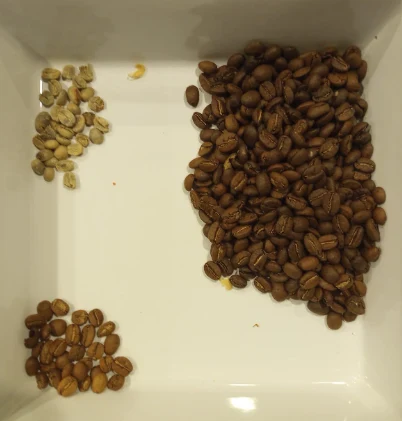The Ultimate Guide: How to Make French Press Coffee?
Coffeeflare is reader-supported. When you buy through links on our site, we may earn an affiliate commission.

Welcome to the ultimate guide on how to make French press coffee! If you’re a coffee enthusiast looking to savor the rich and robust flavors of this brewing method, you’ve come to the right place. In this comprehensive article, we’ll walk you through the step-by-step process of preparing a perfect cup of French press coffee, from choosing the right beans to mastering the brewing technique. Get ready to awaken your senses and indulge in the delightful art of French press coffee brewing.
I. Understanding the French Press

A. What is a French Press?
The French press, also known as a press pot or plunger pot, is a classic brewing device that consists of a cylindrical glass or stainless steel beaker, a lid with a plunger, and a mesh filter. It allows coffee grounds to steep directly in hot water, resulting in a full-bodied and flavorful cup of coffee.
B. Advantages of Using a French Press
- Robust Flavor: French press brewing extracts the natural oils and flavors from the coffee beans, resulting in a rich and aromatic brew.
- Control over Brew Strength: You can customize the strength of your coffee by adjusting the coffee-to-water ratio and steeping time.
- Simple and Portable: French presses are easy to use, clean, and transport, making them ideal for home use or on-the-go coffee lovers.
C. Factors to Consider When Choosing a French Press
- Size and Capacity: Consider the number of cups you want to brew at a time and choose a French press that accommodates your needs.
- Material: French presses are available in glass, stainless steel, or plastic. Each has its pros and cons in terms of durability, heat retention, and aesthetics.
- Filter Design: Look for a French press with a fine-mesh filter to prevent grounds from ending up in your cup.
II. Selecting the Right Coffee Beans

A. Exploring Different Coffee Bean Varieties
Coffee beans come in various varieties, including Arabica and Robusta. Arabica beans are known for their nuanced flavors and pleasant acidity, while Robusta beans offer a bolder and stronger taste.
B. Determining the Roast Level for French Press Brewing
French press coffee pairs well with medium to dark roasted beans. These roasts bring out the rich flavors and body while maintaining a balance between acidity and bitterness.
C. Grinding Coffee Beans for French Press
- Coarse Grind: For French press brewing, it’s crucial to use a coarse grind to prevent over-extraction. This allows the water to flow through the grounds and extract the desirable flavors without resulting in a bitter taste.
- Burr Grinder vs. Blade Grinder: Invest in a burr grinder for consistent grind size, as blade grinders can produce uneven particles.
III. Measuring the Perfect Coffee-to-Water Ratio

A. The Golden Rule of Coffee-to-Water Ratio
The recommended coffee-to-water ratio for French press brewing is 1:15 or 1:16, meaning one part coffee to fifteen or sixteen parts water. This ratio provides a balanced extraction and allows you to adjust the strength according to your preference.
B. Calculating Coffee and Water Measurements
To determine the amount of coffee and water needed, weigh your coffee grounds using a kitchen scale and measure the water using a volume indicator on the French press or a separate measuring cup.
C. Adjusting Ratios Based on Personal Preference
Feel free to experiment with the coffee-to-water ratio to customize your brew. If you prefer a stronger cup, increase the amount of coffee, or decrease it for a milder taste.
IV. Water Temperature and Quality
A. Optimal Water Temperature for French Press Coffee
The ideal water temperature for French press brewing is between 195°F (90°C) and 205°F (96°C). Boil the water and let it sit for about 30 seconds to achieve the desired temperature.
B. Filtered Water vs. Tap Water
While tap water can be used for French press coffee, filtered water is preferable as it removes impurities that may affect the taste. Avoid using distilled or softened water, as they can result in a flat-tasting brew.
C. Importance of Preheating the French Press
Preheating the French press helps maintain the water temperature throughout the brewing process. Simply rinsing the beaker with hot water before adding coffee grounds will suffice.
V. Brewing Process Step-by-Step

A. Preparing the French Press
- Remove the plunger and mesh filter from the French press.
- Add hot water to the beaker to preheat it, then discard the water.
B. Adding Coffee Grounds
- Add the desired amount of coarse-ground coffee to the empty French press beaker.
- Distribute the grounds evenly for consistent extraction.
C. Blooming the Coffee
Pour a small amount of hot water over the coffee grounds, just enough to saturate them. Allow it to bloom for about 30 seconds, releasing trapped gases and enhancing flavors.
D. Pouring the Hot Water
Slowly pour the remaining hot water over the bloomed coffee grounds in a circular motion, ensuring all the grounds are fully immersed. Leave a small gap at the top to prevent overflow.
E. Stirring and Allowing Steep Time
Gently stir the coffee-water mixture to ensure even extraction. Place the lid with the plunger on top but do not press it down. Let the coffee steep for 4-5 minutes.
F. Plunging and Serving
Slowly press the plunger down, applying gentle and steady pressure. This separates the coffee grounds from the liquid. Pour the brewed coffee into cups immediately to prevent over-extraction.
VI. Troubleshooting Common Issues
A. Over-Extraction and Bitterness
If your coffee tastes bitter, adjust the brew time or use a coarser grind to decrease extraction. Experimentation will help you find the ideal balance.
B. Under-Extraction and Weak Flavor
If your coffee tastes weak, increase the brew time slightly or use a finer grind to enhance extraction. Remember to maintain the recommended coffee-to-water ratio.
C. Sediment in the Coffee
Fine sediment in the coffee is normal with French press brewing. To minimize sediment, let the brewed coffee sit for a minute before pouring, allowing the grounds to settle.
D. Cold or Lukewarm Brew
If your coffee turns out cold, preheat your French press and cups, and use water at the appropriate temperature. Also, ensure you’re using an insulated French press or transfer the coffee to a preheated thermos to maintain warmth.
VII. Experimenting with Flavors and Additions

A. Enhancing the Flavor with Spices
Add a pinch of cinnamon, nutmeg, or cardamom to the coffee grounds before brewing for a delightful twist of flavor.
B. Trying Different Types of Milk
Explore various milk options like whole milk, almond milk, or oat milk to complement your French press coffee. Froth the milk separately or use a milk frother for a café-style experience.
C. Sweeteners and Syrups
Customize your cup of French press coffee with natural sweeteners like honey, maple syrup, or flavored syrups. Stir them into the brewed coffee to achieve your preferred level of sweetness.
VIII. Cleaning and Maintenance
A. Proper Cleaning Routine for French Press
Disassemble the French press by removing the plunger and mesh filter. Rinse the parts with warm water and mild dish soap. Scrub the filter gently to remove any coffee residue. Air-dry thoroughly before reassembling.
B. Removing Coffee Stains and Residue
Stubborn coffee stains can be removed by soaking the French press parts in a mixture of equal parts water and white vinegar. Scrub gently with a non-abrasive brush, rinse, and dry.
C. Maintaining the Longevity of Your French Press
Handle your French press with care to prolong its lifespan. Avoid subjecting it to extreme temperature changes, such as placing a hot French press on a cold surface.
IX. Storing Coffee Beans and Grounds
A. Best Practices for Storing Coffee Beans
Store coffee beans in an airtight container, away from heat, light, and moisture. Avoid storing them in the refrigerator or freezer, as moisture can affect the flavor.
B. Storing Ground Coffee
If you prefer pre-ground coffee, store it in airtight containers or resealable bags, away from direct sunlight and heat. Use it within two weeks for the best flavor.
X. Exploring Alternative Brewing Methods
A. Comparing French Press to Other Brewing Methods
Understand the differences between French press, pour-over, espresso, and other brewing methods to choose the one that best suits your preferences.
B. Cold Brew French Press Variation
Use the French press to make cold brew coffee by adding coarsely ground coffee and cold water. Let it steep in the refrigerator overnight, then press and serve over ice.
C. French Press for Tea
The French press is not limited to coffee. It can be used to steep loose-leaf tea as well. Simply replace coffee grounds with your favorite tea leaves and follow the same steeping process.
XI. Serving and Enjoying Your French Press Coffee
A. Pouring and Decanting
Pour the brewed coffee gently into cups, avoiding agitation to prevent the release of any sediment. Consider using a decanter for a cleaner pour.
B. Serving Temperature
French press coffee is best enjoyed immediately after brewing. Preheat your cups, if desired, to maintain the optimal serving temperature.
C. Pairing Coffee with Accompaniments
Pair your French press coffee with a variety of food choices. Enjoy it with pastries, biscuits, dark chocolate, or even cheese to enhance the flavor experience.
Conclusion
Congratulations! You’re now equipped with all the knowledge and expertise needed to make the perfect French press coffee. Remember, practice makes perfect, so don’t be discouraged if your first attempts aren’t flawless. With time and experimentation, you’ll develop a deep understanding of the intricacies involved in French press brewing. So, grab your French press, choose your favorite coffee beans, and embark on a delicious journey to unlock the extraordinary flavors that await in each cup.
Also, Check out the How Many Scoops of Coffee per Cup?
How do I make French press coffee?
To make French press coffee, add coarse-ground coffee to a French press, pour hot water over it, let it steep for a few minutes, and then press down the plunger to separate the grounds from the brewed coffee.
What is the ideal water temperature for French press coffee?
The recommended water temperature for French press coffee is between 195°F (90°C) and 205°F (96°C) to ensure optimal extraction of flavors.
How long should I steep French press coffee?
Steep French press coffee for about 4 to 5 minutes to extract the desired flavors. Adjust the steeping time based on your taste preferences.
What is the best grind size for French press coffee?
For French press brewing, use a coarse grind size to prevent over-extraction and avoid sediment in your coffee.
Can I use pre-ground coffee for French press brewing?
Yes, you can use pre-ground coffee for French press brewing. Just make sure the grind size is suitable for French press to achieve optimal results.
How much coffee should I use in a French press?
The general guideline is to use a ratio of 1 part coffee to 15 or 16 parts water. Adjust the amount of coffee based on your preferred strength.
Can I make cold brew using a French press?
Yes, you can make cold brew coffee using a French press. Simply add coarse-ground coffee and cold water to the French press, let it steep in the refrigerator overnight, and then press and serve over ice.
How do I clean a French press?
Disassemble the French press, rinse the parts with warm water and mild dish soap, and scrub the mesh filter gently to remove any coffee residue. Air-dry thoroughly before reassembling.
Can I use a French press to brew tea?
Yes, a French press can be used to steep loose-leaf tea. Replace coffee grounds with tea leaves, follow the same steeping process, and enjoy your brewed tea.
What is the advantage of using a French press for coffee brewing?
French press brewing allows for full extraction of coffee flavors, resulting in a rich and robust cup of coffee. It also provides control over brew strength and is portable and easy to use.






